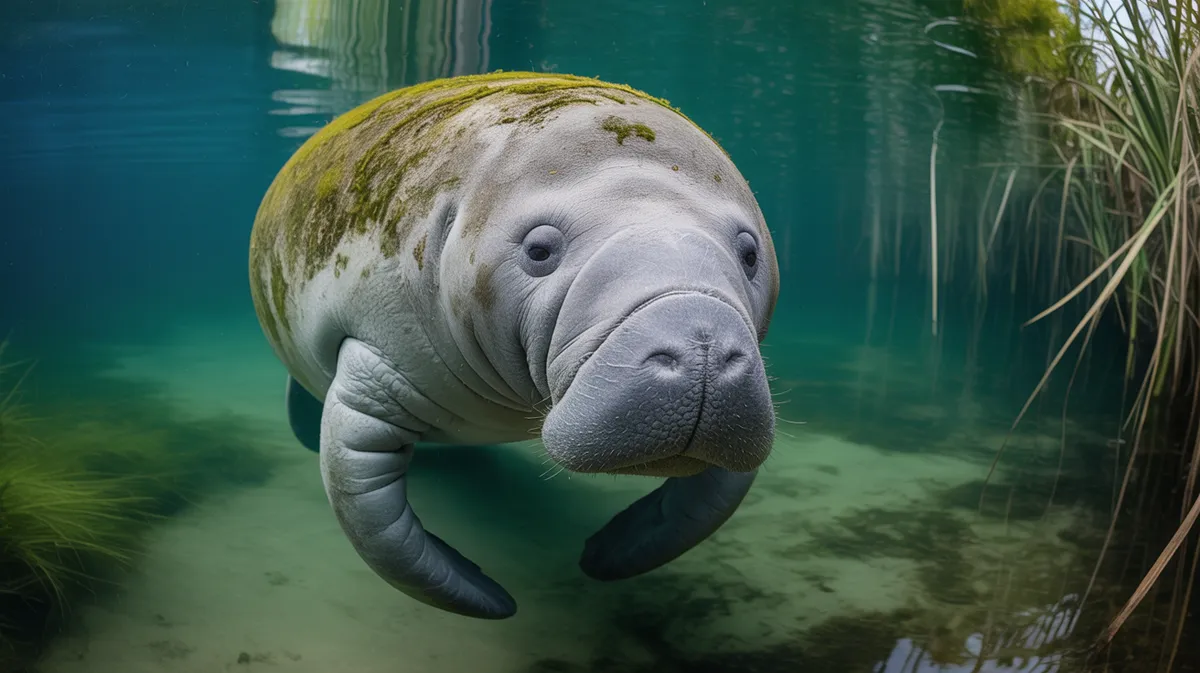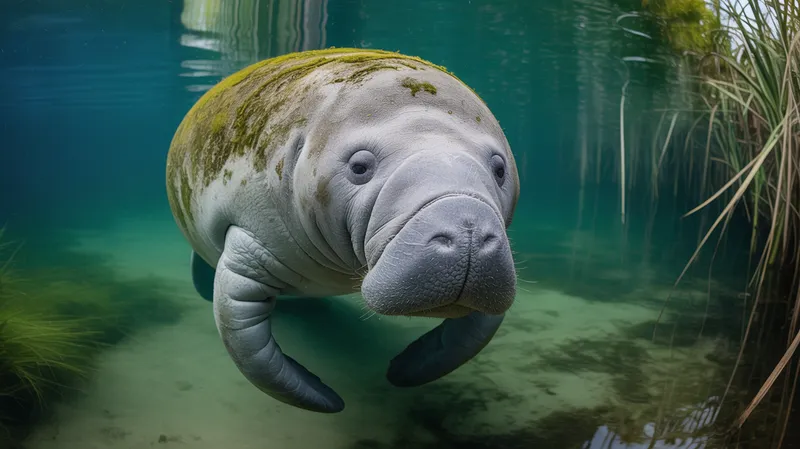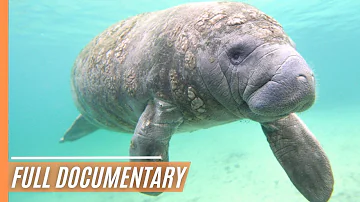
Florida Manatee
Trichechus manatus latirostris

Meet the Florida Manatee
The Florida manatee is a large, slow-moving aquatic mammal native to the warm coastal waters and rivers of Florida and the southeastern United States. Recognizable by its rounded, paddle-shaped tail and wrinkled, grayish skin, it can grow up to 13 feet in length. These gentle herbivores spend most of their day grazing on aquatic vegetation and are known for their calm, docile nature. Manatees are highly vulnerable to human activities, especially boat collisions, and rely on warm-water refuges during colder months.
Classification
Mammal
Habitat
Shallow coastal waters, rivers, estuaries, and freshwater springs
Diet
Herbivore
Lifespan
40-60 years
Conservation
Vulnerable
Weight
400-1,300 pounds
📖Fascinating Facts
Vegetarian Giants
Florida manatees feed mostly on seagrass and freshwater vegetation, consuming over 100 pounds per day.
Boat Collision Risk
One of the leading causes of manatee injury and death is collision with watercraft due to their slow movements and surfacing habits.
Unique Teeth Replacement
Manatees continuously grow new teeth throughout their lives, with old teeth being replaced by new ones moving forward from the back of the jaw.
📋Detailed Description
The Florida manatee (Trichechus manatus latirostris) is a robust, aquatic mammal distinguished by its large, fusiform body, wrinkled gray skin, and a broad, paddle-shaped tail. Adults typically measure between 2.7 and 4.0 meters (9–13 feet) in length and weigh from 400 to 550 kilograms (880–1,210 pounds), though exceptionally large individuals may exceed 1,500 kilograms (3,300 pounds). Their forelimbs are modified into flexible flippers, each with three to four nails, aiding in steering and food manipulation. Manatees possess a sparse covering of bristle-like hairs and a dense array of vibrissae (whiskers) around the snout, which are highly sensitive and play a crucial role in tactile exploration and foraging. Internally, they have a large, elongated digestive tract adapted for fermenting tough aquatic plants. Florida manatees are obligate aquatic mammals, surfacing to breathe every 3–5 minutes during activity, though they can hold their breath for up to 20 minutes at rest. They exhibit slow, graceful movements, generally swimming at 3–5 km/h (2–3 mph), but can reach bursts of 30 km/h (20 mph) if startled. Social structure is loosely organized; individuals are often solitary but may form temporary aggregations, especially at warm-water sites in winter. Manatees are non-territorial and exhibit minimal aggression, with interactions largely limited to mother-calf pairs or breeding herds. Their gentle disposition and slow metabolism are reflected in their docile, unhurried behavior. Lifespan in the wild can exceed 60 years, though many succumb earlier due to anthropogenic threats.
💡 Did you know?
Manatees have no natural predators, but their greatest threat comes from human-related activities, especially boat strikes.
🔬Research & Sources
Wikipedia Summary
The West Indian manatee, also known as the North American manatee, is a large, aquatic mammal native to warm coastal areas of the Caribbean, from the Eastern United States to northern Brazil. Living alone or in herds, it feeds on underwater plants and uses its whiskers to navigate. It is divided into two subspecies, the Florida manatee in the United States and the Antillean manatee in the Caribbean, both of which are endangered and face pressure from habitat loss, pollution, and other human activity. The West Indian manatee is the largest living member of the sirenians, a group of large aquatic mammals that includes the dugong, other manatees, and the extinct Steller's sea cow.
Last Modified: 4/30/2025
🎭Behavior & Social Structure
Florida manatees are primarily diurnal but may be active at any time of day. They spend up to 8 hours daily feeding and the remainder resting or traveling. Feeding involves slow grazing on submerged, emergent, and floating vegetation, using their prehensile upper lips to grasp and manipulate food. They consume 4–9% of their body weight in vegetation per day, favoring seagrasses (Halodule, Thalassia) and freshwater plants (Hydrilla, Vallisneria). Social interactions are generally limited, but manatees communicate through vocalizations—chirps, squeaks, and whistles—especially between mothers and calves. During the winter, large aggregations form at warm-water refuges, such as natural springs and power plant outflows, where social tolerance increases. Manatees are inquisitive and may investigate novel objects or humans, but they lack complex social hierarchies. Grooming is performed by rubbing against substrates or other manatees. Daily routines are influenced by temperature, tidal cycles, and food availability.
👶Reproduction & Life Cycle
Florida manatees are polygynandrous, with no permanent pair bonds. Breeding occurs year-round, peaking in spring and summer. During estrus, several males (up to 20) form a 'mating herd' around a receptive female, competing for access. Gestation lasts approximately 12–14 months, after which a single calf (rarely twins) is born, measuring about 1.2–1.4 meters (4–4.5 feet) and weighing 30–35 kilograms (66–77 pounds). Calves are precocial, swimming and surfacing within minutes of birth. Maternal care is intensive; calves nurse for up to 2 years, although they begin sampling vegetation within weeks. Females reach sexual maturity at 3–6 years, males at 5–9 years. Calving intervals are typically 2–5 years, depending on maternal condition and calf survival.
🛡️Adaptations & Survival
Florida manatees exhibit several adaptations for aquatic herbivory and thermoregulation. Their dense bones (pachyosteosclerosis) provide ballast for buoyancy control in shallow waters. The prehensile, split upper lip is specialized for grasping and manipulating a variety of aquatic plants. Manatees have a highly flexible diaphragm and lungs that extend along the back, facilitating efficient buoyancy control and prolonged dives. Their slow metabolic rate and large size reduce heat loss, but they lack insulating blubber, making them susceptible to cold stress below 20°C (68°F). The vibrissae on their snout and body serve as tactile sensors, aiding in navigation and food detection in turbid waters. Their molars are replaced continuously throughout life (marching molars), an adaptation to abrasive diets. Manatees also possess a unique, low-frequency hearing range, well-suited to underwater communication.
📚Research Sources
🎨Cultural Significance
Florida manatees have long been part of local folklore, sometimes mistaken for mermaids by early European explorers. They are a flagship species for aquatic conservation in Florida, symbolizing the need for habitat protection and responsible boating. Manatees are featured in educational programs, ecotourism, and state iconography. They are protected under the U.S. Marine Mammal Protection Act and the Florida Manatee Sanctuary Act. There are no known traditional uses of manatees by indigenous peoples in Florida, but they hold considerable value as ambassadors for wetland and coastal ecosystem preservation.
🔬Recent Research & Discoveries
Recent research has focused on manatee health, genetics, and movement ecology. Satellite telemetry has revealed extensive seasonal migrations, with individuals traveling hundreds of kilometers between summer and winter habitats. Studies on immune function and disease have highlighted susceptibility to brevetoxins from red tide events. Genetic analyses indicate low diversity, raising concerns about resilience to environmental change. Ongoing research is investigating the impacts of seagrass loss and restoration efforts, as well as the effectiveness of boat speed zones and warm-water refuge management. Advances in acoustic monitoring are improving detection and understanding of manatee communication and habitat use. The Florida Fish and Wildlife Conservation Commission (FWC) and U.S. Geological Survey (USGS) maintain long-term monitoring and rescue programs.
🎥Wildlife Videos

Marvelous Manatees: Gentle Giants of the Sea | Full Documentary
As a manatee, one has to be extremely unlucky to be given a name. The young Hamilton is a living example of this. 600 kilos of ...
Free High-Quality Documentaries

Is It Too Late For The Manatees? (Wildlife Documentary) | The Blue Realm | Real Wild
Each year, hundreds of critically endangered manatees are killed in U.S. waters by boats, disease and cold weather. With only a ...
Real Wild

Exotic Animals of Florida - Alligators, Manatees & Turtles - 4K Everglades National Park Documentary
Welcome to Everglades National Park! Watch the ultimate wildlife documentary about Florida's most fascinating ecosystem.
Animals and Pets

Breathtaking insights into the amazing ecosystem of the Everglades National Park | Full Documentary
North America's National Parks are world famous and their breathtaking landscapes fascinate millions of visitors. This spectacular ...
Free High-Quality Documentaries

The Florida Manatee
The Florida manatee is a conservation success story, with as few as 1000 remaining in the wild just a few decades ago.
Odyssey Earth

The Florida River Becoming a Refuge for Manatees | WILD HOPE
Crystal River has long been a safe haven for the Florida manatee, but when an invasive algae wiped out the eelgrass that ...
Nature on PBS
🌍Habitat Information
The Florida Manatee typically inhabits Shallow coastal waters, rivers, estuaries, and freshwater springs environments. Florida Manatees have adapted to their environments with specialized features and behaviors.
Primary Habitat:
Shallow coastal waters, rivers, estuaries, and freshwater springs
More detailed habitat information will be available soon.
🛡️Conservation Status
The Florida Manatee is currently classified as Vulnerable. Conservation efforts are crucial for preserving this species for future generations.
Common Threats:
- 🏠Habitat loss and fragmentation
- 🌡️Climate change impacts
- 🎯Hunting and poaching
- 🏭Human-wildlife conflict
⚠️Threats & Conservation Challenges
Major threats to Florida manatees include boat collisions, which account for a significant proportion of mortalities annually. Habitat loss and degradation, particularly the decline of seagrass beds due to pollution, algal blooms, and coastal development, further threaten populations. Cold stress during winter can cause mass die-offs, especially when access to warm-water refuges is restricted. Entanglement in fishing gear, ingestion of debris, and red tide (Karenia brevis) blooms also pose risks. The population has shown signs of recovery due to conservation efforts, with recent estimates (2023) suggesting 6,000–7,500 individuals in Florida, but episodic mass mortality events (notably in 2021–2022) have reversed some gains. Climate change, water quality decline, and increasing human activity remain ongoing challenges for long-term survival.
🔬Scientific Classification
Scientific Name
Trichechus manatus latirostris
Classification Hierarchy
🔍 About Taxonomic Classification
Taxonomic classification is a hierarchical system used by scientists to classify and organize living organisms based on shared characteristics and evolutionary relationships.
The system moves from broad categories (Kingdom) to increasingly specific ones, with each animal's scientific name typically consisting of its Genus and species.
📝Community Notes
Share your observations and insights about the Florida Manatee with our community of wildlife enthusiasts.
Join Our Community
Sign in to share your observations and connect with fellow wildlife enthusiasts.
Sign In to ContributeNo community notes yet
Be the first to share your observations about the Florida Manatee!
Explore Florida Manatee
Select a tab above to learn more about this amazing animal.
📸Photo Gallery
No photos available for this animal yet.
🌟Discover More Wildlife
Continue your journey of discovery with more fascinating animals from our database
